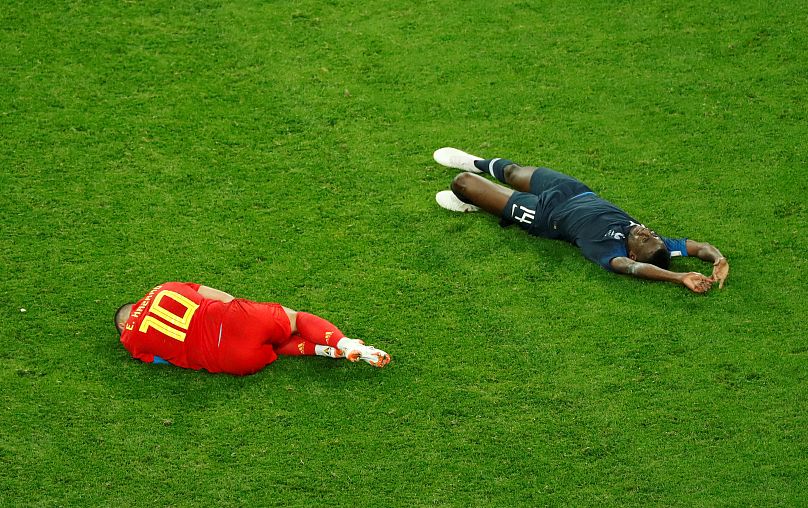What's changed since Moroccan Nordin Amrabat’s decision to play in the group stages following a concussion five days prior?
This year's World Cup in Russia may have ended — but the debate about concussions in the sport continues.
From the moment France's Blaise Matuidi was announced in the starting lineup for the final match against Croatia, concerns over the midfielder poured in from both pundits and fans.
Earlier in the week, Matuidi was thrown back during a heavy collision with Belgium's Eden Hazard in the semi-final, when the Frenchman was seen lying on the pitch and appeared dazed.
Reports claimed that medics ruled that Matuidi was not concussed. But campaigners thought otherwise, as they did earlier following other clashes in the tournament.
Following Moroccan Nordin Amrabat’s decision to play against Portugal after sustaining a concussion five days prior, FIFA and the world players' union had issued statements of concern.
Amrabat was taken off the game against Iran on June 15 after suffering a concussion, memory loss and spending the night in the hospital. While FIFA does not have the authority to enforce the recommended six days on the sidelines following a concussion, Amrabat drew criticism for not only returning to play so soon, but also for discarding his protective headgear a few minutes into the game (wearing the gear was his own choice).
"Following the questionable handling of the concussion incident involving the Moroccan player… FIFA wrote to the Moroccan team doctor to remind him of the importance to adhere to the guidelines that have been communicated," FIFA said in a statement. “While the assessment and case management of concussion incidents falls under the sole responsibility of the respective team doctors, FIFA will address this matter with the Moroccan FA and, speaking in general terms, FIFA will monitor closely this matter throughout the competition."
The world players’ union Fifpro expressed its concern on Twitter.
Chairman of FIFA’s medical committee, Michel D’Hooghe, spoke to the Morocco team doctor, Abderrazak Hifti, that had allowed Amrabat to play.
“He accepted the fact that the player should not have played after five days but that he needed six days,” D’Hooghe told The Telegraph. Hifti allegedly admitted to buckling under pressure from the player himself, and said it wouldn’t happen again.
Debate carries on again
This isn’t the first time a concussion has sparked debate during the World Cup.
Research conducted by the department of neurosurgery at St Michael’s Hospital in Toronto in 2017 found that two-thirds of head collision incidents in the 2014 Brazil World Cup were failed to be properly assessed by healthcare personnel, as per FIFA’s own guidelines.
Led by Michael Cusimano, the research strove to understand the kind of healthcare athletes were receiving at an elite level.
Based on footage of the games, of 67 injured players with two or more signs of a concussion, only 16% received sideline assessment by a healthcare professional. Of these, all assessments were brief, the longest being 180 seconds.
“It is almost impossible to do an assessment in that short a time,” said Cusimano to The Guardian.
Dr. Barry Seemungal, a neurologist at Imperial College London, explained that the standards by which athletes’ concussions are evaluated come from the Sport Concussion Assessment Tool 5th edition (SCAT5). This test, which is the current sporting body consensus, cannot be performed correctly in under 10 minutes.
In the 2014 final of the World Cup, German midfielder Christoph Kramer took a blow to the head, after which he continued playing, despite authorities being aware that the player, in a state of lowered awareness and confusion, had asked the referee whether he was in the final. A few minutes after this exchange, Kramer collapsed in the middle of the game. This incident, among others, sparked outrage in the world players’ union over FIFA’s lack of appropriate care for its players, especially when there is evidence of a concussion.
According to SCAT guidelines, if there is any evidence of a concussion, the player should be removed from play.
According to Seemungal, the medical approach is now in favour of assessing concussions based on evidence of obtundation, or a period of lessened alertness due to brain dysfunction, characterised by apparent confusion or no ability to balance.
When an athlete has suffered a concussion, their ability to think is impaired, Seemungal explains. So a player may not even be aware of his problem and insist that he is fine, when a doctor may assess that he is not.
Regardless, Seemungal says, an objective assessment is necessary.
FIFA rule 'arbitrary'
FIFA’s recommended six-day sideline rule for concussions is reasonable but arbitrary, according to Seemungal. There is no evidence that all players should wait a minimum of six days following a concussion to return back to the field. Nonetheless, it is understandable the organisation needs some sort of guideline.
“Their guideline is something that is consensus rather than evidence-based… When [in science] we don’t have evidence, we need to have an opinion. It’s the only thing we have up until hard evidence comes to light,” Seemungal says.
FIFA did not respond to Euronews' requests for comment.
Seemungal speculates that had Amrabat really still been injured during the match, he would not have been able to perform at as high a level as he did.
“I felt like I had heavy legs during the game [Wednesday] but overall it was fine" he told ESPN.
The Federation of European Neuroscience Societies hosted a concussion seminar in Berlin on July 12 where medical and legal experts from Europe and the UK convened. According to Seemungal, they concluded, in agreement, that use of the word "concussion" is acceptable to describe an event, but not for a diagnosis. The most common approach to head collisions is to diagnose a player with the concussion, whereas usually, Seemungal says, concussions are accompanied by at least one other condition that needs proper analysis and diagnosis.
Seemungal's research is funded by the Medical Research Council.












